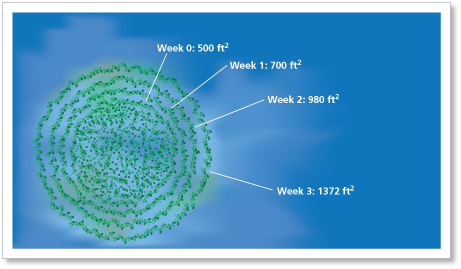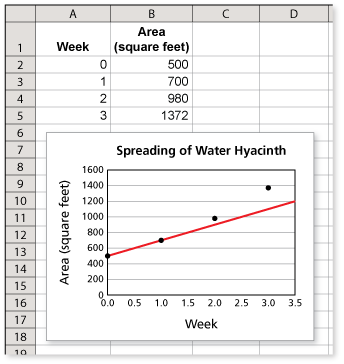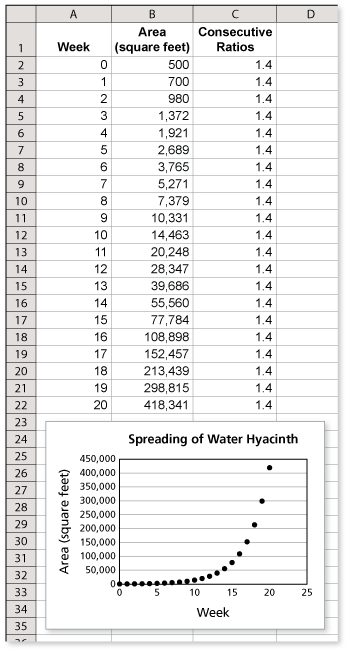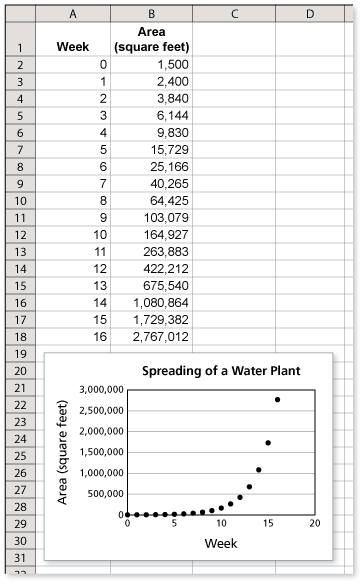-
An invasive species of water hyacinth is spreading over the surface of a lake. The figure shows the surface area covered by the water hyacinth over a 3-week period. Is the pattern linear? Explain your reasoning. (See Example 1 and Example 2.)
-
Begin by entering the data into a spreadsheet. Then draw a scatter plot for the data.
Because the points on the scatter plot do not lie on a line, the pattern is not linear.A second way to see that the data is not linear is to observe that the area is not increasing by the same amount with each successive week.
Comments (0)These comments are not screened before publication. Constructive debate about the information on this page is welcome, but personal attacks are not. Please do not post comments that are commercial in nature or that violate copyright. Comments that we regard as obscene, defamatory, or intended to incite violence will be removed. If you find a comment offensive, you may flag it.
When posting a comment, you agree to our Terms of Use.Showing 0 commentsSubscribe by email Subscribe by RSSThere are no comments. -
-
An invasive species of water hyacinth is spreading over the surface of a lake. The figure shows the surface area covered by the water hyacinth over a 3-week period. At what rate is the surface area covered by the water hyacinth increasing? (See Example 1 and Example 2.)
These comments are not screened before publication. Constructive debate about the information on this page is welcome, but personal attacks are not. Please do not post comments that are commercial in nature or that violate copyright. Comments that we regard as obscene, defamatory, or intended to incite violence will be removed. If you find a comment offensive, you may flag it.
When posting a comment, you agree to our Terms of Use. -
An invasive species of water hyacinth is spreading over the surface of a lake. The figure shows the surface area covered by the water hyacinth over a 3-week period. Use a spreadsheet to extend the pattern to 20 weeks. Then make a scatter plot of the data and describe the graph. (See Example 1 and Example 2.)
-
Begin by observing with each week, the area is 1.4 times greater than the week before. Using this factor, you can make a spreadsheet for the first 20 weeks.
Notice that if this pattern continues for 20 weeks, the area covered by the water hyacinth is over 400,000 square feet.
These comments are not screened before publication. Constructive debate about the information on this page is welcome, but personal attacks are not. Please do not post comments that are commercial in nature or that violate copyright. Comments that we regard as obscene, defamatory, or intended to incite violence will be removed. If you find a comment offensive, you may flag it.
When posting a comment, you agree to our Terms of Use. -
-
An invasive species of water hyacinth is spreading over the surface of a lake. The figure shows the surface area covered by the water hyacinth over a 3-week period. The surface area of the lake is about 800,000 square feet. How many weeks does it take the water hyacinth to cover the entire lake? (See Example 1 and Example 2.)
These comments are not screened before publication. Constructive debate about the information on this page is welcome, but personal attacks are not. Please do not post comments that are commercial in nature or that violate copyright. Comments that we regard as obscene, defamatory, or intended to incite violence will be removed. If you find a comment offensive, you may flag it.
When posting a comment, you agree to our Terms of Use.Showing 3 commentsCody (moderator)1 decade ago |Thank you for your comment. Input from experts such as yourself is invaluable and helps us to create a better book.
Our writers researched linear range expansion and Skellam's model and understand your concern. The rate of 40% you observed is based on a doubling time of approximately 2 weeks. Here are some of our sources concerning the doubling time of the water hyacinth:
"Water hyacinth and other floating weeds are extremely invasive because of their clonal reproductive action. They sit on the water surface and spread in two dimensions. Growth rates are high. Hyacinth has a doubling time of approximately 13 days."
Source: http://www.wssnc.ncsu.edu/pro1999.htm 4/
"Under favorable conditions, the area doubling time for water hyacinth ranges between 11-18 days, depending on the weather."
Source: Organic Waste Recycling: Technology and Management 3e, page 318, http://books.google.com/books?id=owycqJMjoZoC&pg=PA318
Also, our research turned up some exceptions to linear range expansion that may interest you:
"Linear range expansion has been found to be a good approximation of the historical spread of muskrat in Europe. However, this assumption does not hold for many species in which range expansion accelerates over time such as Argentine ants (Suarez et al. 2001), cheat grass (Mack 1981), and the rice water weevil (Andow et al. 1993)."
Source: footnote of page 5 of http://www.webmeets.com/files/papers/WCERE/2010/794/Barriers-WC10-blind.pdf
Another example of nonlinear range expansion is the yellow starthistle.
Source: http://www.cal-ipc.org/symposia/archive/pdf/1997_symposium_proceedings1937.pdf
Once again, we appreciate your comment. If you have any more concerns or questions, or would like to learn more about our company, feel free to send me an email at cbernardini@larsontexts.com or use the contact form on this website. As a math company, we enjoy talking with other mathematicians.
Thanks,
Cody0 0Ron Larson (author)1 decade ago |Thanks for the comment. I will incorporate your suggestions in the next edition of the text.0 0Guest 1 decade ago |I'm a mathematical ecologist, and found this example while browsing. It bothers me a bit because exponential growth in a spatial setting is actually extremely unrealistic. There are plenty of invasive or introduced species that grow exponentially (at least initially: e.g. caribou in the Pribilof islands, monk parakeets ... see lots of examples in ecology textbooks), but almost all data on *spatial* spread suggests linear growth in area covered per unit time (muskrats in central Europe are a classic example). Not to mention that 40% growth per week is pretty surprising for a plant (maybe not for bacteria) ...0 0 -
An invasive species of water plant covers 1500 square feet of the surface of a lake. The lake has a surface area of about 2,500,000 square feet. The surface area covered by the plant increases by 60% each week. Make a table and a scatter plot showing the surface area covered by the plant until the plant covers the entire lake. (See Example 1 and Example 2.)
-
A spreadsheet showing the area covered by the invasive species is shown below.
If the area increases by 60% each week, it will cover the entire lake sometime during the 16th week.
These comments are not screened before publication. Constructive debate about the information on this page is welcome, but personal attacks are not. Please do not post comments that are commercial in nature or that violate copyright. Comments that we regard as obscene, defamatory, or intended to incite violence will be removed. If you find a comment offensive, you may flag it.
When posting a comment, you agree to our Terms of Use. -
-
Suppose in Exercise 5 that the surface area covered by the plant increases by only 20% each week. How much longer does it take the plant to cover the entire lake? (See Example 1 and Example 2.)
These comments are not screened before publication. Constructive debate about the information on this page is welcome, but personal attacks are not. Please do not post comments that are commercial in nature or that violate copyright. Comments that we regard as obscene, defamatory, or intended to incite violence will be removed. If you find a comment offensive, you may flag it.
When posting a comment, you agree to our Terms of Use.










